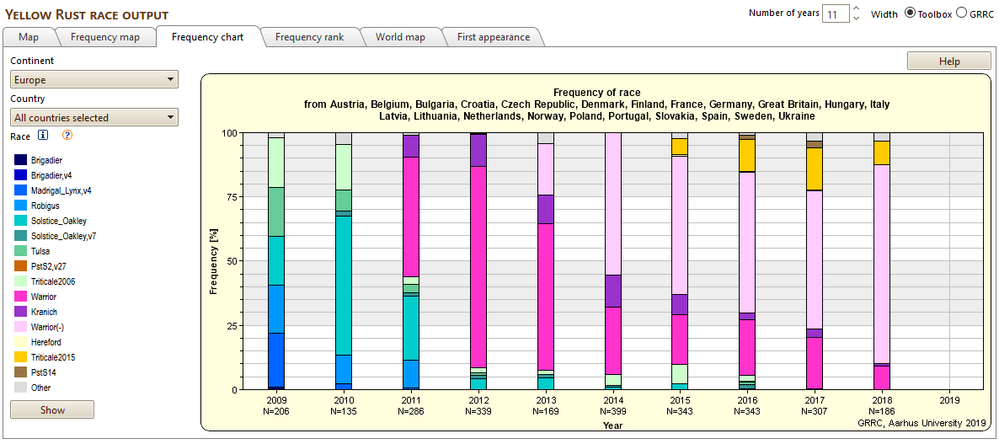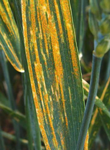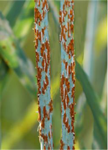Wheat rusts threaten European wheat production
Wheat rusts are causing serious damage across Europe this year. All three rusts (yellow rust, leaf rust and stem rust) are being reported by collaborators in the H2020 EU RustWatch project

Watch this video of the yellow tractor
In Sicily there are currently about 150,000 ha affected by leaf rust, 50,000 ha affected by yellow rust and at least 50,000 ha affected by stem rust. – posing a potential threat to crops on mainland Italy and other neighbouring countries. The outbreaks of stem rust follow similar outbreaks in Sicily in 2016 (Stem rust reappeared in Europe at epidemic level in 2016 - in Sicily). Severe yellow and leaf rust attacks have also been reported from Spain, Belgium, Northern France, UK and Denmark.
Yellow rust, in particular, is very severe in several EU countries, with some unusual patterns of varieties affected. Project partners are currently testing yellow rust samples to determine whether there may be new races affecting these varieties. News on any new races will be available in the near future so that farmers can make better choices of varieties for this autumn. Early testing of the yellow rust samples from Sicily, Belgium, France and Denmark, tested by The Global Rust Reference Centre in Denmark, do suggest that some new races may be involved in the severe attacks of yellow rust.
The rust problem on wheat and other cereals is being addressed via international collaboration because of the risk of aerial spread of rust spores to other countries. The launch of RustWatch in 2018, a new European early-warning system for wheat rust diseases, could not have been more timely. The RustWatch consortium and related stakeholders can act quickly in such circumstances, raising awareness and providing information on any new races of rust that may appear. This information can be used by farmers and also by plant breeding companies. The consortium is encouraging farmers and advisers throughout Europe to record outbreaks of rusts. We will launch a crowdsource App to report rust on varieties to a common EU system.
The early warning system involves a network of specialists across Europe with links to farmers and advisers. The aim is to provide fast and reliable diagnostic and reporting tools. On-line and app-based tools allow users to report outbreaks and give early warning of outbreaks. Any changes in the rust populations can be detected using molecular genotyping so that advice can be given to growers and plant breeders about possible changes to varietal resistance to the diseases. The prevalence of rust races in Europe will be published on wheatrust.org and associated web-sites. 2019 is the first crop season, where early-warning activities are in place, including coordinated field trials in multiple countries. Detailed assessment of new solutions for the control of rust diseases will be assessed.
Maps and charts outlining outbreaks and changes to races are made freely available. The post-warrior population of yellow rust in Europe is visualised via the frequency of races across years in fig. 2.

Figure 2. Yellow rust races across the years 2009 - 2018 in Europe. See live map here
Information for 2019 from case study regions in RustWatch
UK: Mild winter conditions in 2018/19 allowed both yellow and brown rust to overwinter and appear very early in 2019. Active yellow rust began to develop in January and, although checked slightly in a dry April, has continued to develop throughout the spring. Most severe yellow rust has been reported in the East although reports have been received from many parts of the UK. Yellow rust has been reported on over 22 commercial varieties as well as new varieties, not yet on the UK Recommended List. Major varieties affected by yellow rust include KWS Zyatt, Skyfall, KWS Lili, Elicit, LG Spotlight, Bennington, Revelation, Dunston, Evolution, RGT Gravity, Graham, Gleam, Zulu, Kerrin, LG Graduate, Shabras, LG Rhythm and KWS Santiago. Many of these have high levels of adult plant resistance but are susceptible at the seedling stage. For many, they are susceptible for much of the Spring period.
Brown rust has been common on susceptible varieties such as Crusoe, KWS Siskin, KWS Lili LG Detroit and Dunston, with an unusual attack on KWS Firefly. No outbreaks of Stem Rust have been reported in recent years.
Denmark: In terms of disease severity and area affected, the epidemics of yellow rust this year are the worst since 1990. The epidemics have developed fast in the second half of May, in particular in Benchmark, Kalmar and Sheriff, and less severe disease levels in KWS Zyatt and KWS Lili, Elixer, Graham and Torp. Only trace of yellow rust has been found in Informer. The most widespread epidemics are reported from the southern and eastern part of Jutland and the islands Samsø. Aarhus University states that varieties such as Benchmark, Sheriff and Kalmar are susceptible to already known races of yellow rust in Denmark, but the patterns of susceptibility of these varieties are different from previous years, suggesting that prevalence of races is different in 2019. Brown rust has been observed sporadic with low level of infection, and stem rust has not been observed.
Belgium: In the Spring the pressure from yellow rust was low except on susceptible varieties, especially those susceptible to the Warrior – AV17 race (Nemo, Reflexion and KWS Smart). In late May many other varieties were reported as being affected by yellow rust. The outbreaks are most severe in the warmer part of Belgium (near Liège). Some varieties such as KWS Smart, which is normally resistant at the adult plant stage are showing high levels of infection.
Sicily: Black stem rust, yellow rust and leaf rust are widespread in Sicily, and aggressive yellow rust attacks are reported. In April and May 48 fields and trial sites were inspected. Yellow rust was found in 21 fields, leaf rust in 34 fields and stem rust in 20 fields. According to Biagio Randazzo, AS.A.R the situation is alarming as attacks are severe in some areas and several expected resistant varieties are affected. All three rust type were found on same single plants (Photo 1; Photo 2; Photo 3; Photo 4, all by Biagio Randazzo).
Italy: High levels of yellow rust were detected in Tuscany, Lazio while moderate level have been detected in Sardinia and Apulia. Stem rust has been detected in a breeding station at Foggia (CREA) on 17th May and is spreading in farmers’ fields in Apulia. Currently no stem rust has been detected in other regions of Italy
Navarra Spain: First symptoms of yellow rust were detected by the end of March in soft wheat fields. Rust was found widespread at low levels in during the second half of April. After rain in early May, most farmers sprayed with fungicide to prevent epidemic developments. By the end of May yellow rust was found on varieties that were previously thought to be resistant
RustWatch Project information:
Three rust species infect wheat and are distributed globally, i.e.
- Yellow (stripe) rust caused by Puccinia striiformis f.sp. tritici,
- Leaf (brown) rust caused by Puccinia triticina and
- Stem (black) rust caused by Puccinia graminis f.sp. tritici
These pathogens have a worldwide prevalence and potential for long distance spread. Invasions into new areas pose a serious threat to food security regionally and globally.
| | |
Yellow rust | Leaf rust | Stem rust |
Yellow rust is certainly the most important rust in Europe, followed by brown rust. Stem rust has been insignificant or absent on wheat in Western Europe for more than 60 years. Then, in 2013, pathologists raised the alarm about the re-emergence of the stem rust on wheat at multiple locations in Germany, followed by outbreaks on durum wheat and bread wheat in Sicily in 2016, and in the autumn of 2017, new outbreaks of stem rust were observed on spring wheat in Sweden.
RustWatch will:
- Enable more efficient detection of rust resistance in wheat, and the deployment of rust resistant varieties in Europe.
- Enable testing of elite European wheat varieties and breeding lines in field trials in Europe and the Himalayan region of Pakistan (the global centre of diversity of yellow rust).
- Develop a web-based European early warning system for wheat rusts.
- Provide state-of-the art research with new diagnostic tools enabling rapid and precise identification of new invasive races of rust.
- Investigate the impact of virulence, aggressiveness and adaptation to global warming on pathogen spread and establishment.
- Provide new tools in the testing of host resistance by going beyond the visual observation of disease to categorising resistance at the cellular level.
The project has 24 partners in 13 countries in Europe.
Main source of information for this news story
Biagio Randazzo, AS.A.R. Sicily, Alberto Lafarga, INTIA, Navarra, Spain, Guillaume Jacquemi, CRA, Wallonia, Belgium, Bill Clarke, NIAB, UK, Fabio mascher, AgroScope, SwitzerlandGhita Nielsen, SEGES, Denmark.
Project Coordination
The Project is coordinated by Aarhus University (AU), Department of Agroecology. Mogens S. Hovmøller is the principle coordinator. He is also head of the Global Rust Reference Center hosted by AU. Contact: Mogens S. Hovmøller, Global Rust Reference Center, Aarhus University, AU Flakkebjerg, Forsøgsvej 14200, Slagelse. Denmark. E-Mail: Mogens.hovmoller@agro.au.dk. Direct phone: +45 87158129


